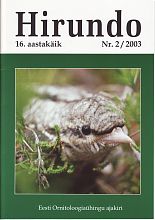Hirundo 2/2003
Elts, J., Kuresoo, A., Leibak, E., Leito, A., Lilleleht, V., Luigujõe, L., Lõhmus, A., Mägi, E. & Ots, M.
Status and numbers of Estonian birds, 1998-2002
PDF
Tuule, E. & Elts, J.
Numbers and population dynamics of the Magpie in the surroundings of Saue, 1963-1998
Summary: Breeding Magpies (Pica pica) were counted in an approximately 100 km2 area in the surroundings of Saue (near Tallinn), in 1963-1998. The landscape is mosaic and the share of open agricultural habitats has increased during the study years. The densities were estimated according to line transect counts on 50-m wide transects. In 1960-ties the Magpie was breeding mainly in scrubland, later the species spread to other biotopes, including human settlements (Figure 1, Table 1). Although the species continuously preferred scrubs, the share of this biotope as breeding place decreased: 84,7% of pairs bred here in 1960-ties, 64,4% in 1970-ties and 32,7% in 1990-ties. Total numbers have increased significantly, 30 pairs of Magpie bred in 60 km2 area in 1963, but about 480 pairs in 1990-ties. Most important reason for the increase is probably the favourable foraging conditions near human settlements and farms.
Lõhmus, A.
The Finnish method of line transects in the light of forest bird censuses in east central Estonia
Summary: The Finnish method of line transects (e.g. Järvinen et al. 1991) is among the main alternatives in estimating population sizes for common and widespread bird species in Estonia (see Ellermaa 2003a). The current paper draws attention to some problems of this method, as revealed by forest bird counts in Tartu county (east-central Estonia) on 30 randomly selected 2-km line transects in 2002-2003.
According to the protocol, a pair is recorded on the basis of a male or, when the male is not seen, then a female, a group of fledglings or a nest is also interpreted as a pair. However, in several well-defined cases, occurrence of one individual on the main belt does not show the occurrence of a pair there. Thus, single non-territorially behaving (foraging, flushed etc.) adult individuals of species with large home-ranges (e.g. Strix uralensis, Dryocopos martius) or non-consistent pairs (e.g. Scolopax rusticola) should rather be quantified as 0.5 pairs in their observation site. Similarly, independent of species, territorial individuals moving freely in and back over belt borders during observation should be assigned as 0.5 pairs to each relevant belt.
Next, I addressed the use of averaged correction coefficients for inclusion of distant observations, since the detectability of distant birds depends much on site and time. An alternative is to use wider but fixed-width survey belts. I compared bird numbers on the conventional 25+25 m main belt and on peripheral belts 25-50 m away. When species were ranked according to the share of distant observations, it appeared that a distinct species group (with less than 20% of pairs >50m away) had to be treated only on the basis of the main belt, whereas for other species, the peripheral belt was likely to increase precision due to larger sample much more than to lose accuracy due to missed pairs (Table 1). When compared with such fixed-width counts, the Finnish method seemed to systematically underestimate both mean densities (Table 3) and their precision (Fig. 2). The density underestimation was probably due to worse-than-average detectability of birds on forest land, indicating that correction coefficients may lead to results of unpredictable accuracy. At least twenty (not four, as proposed by Ellermaa 2003a) pairs on survey belt were needed to acquire meaningful confidence intervals (about half of the mean at 95% probability). I roughly calculated that mean densities of species with national populations less than 10 000 pairs can not be estimated reliably with transect counts in Estonia.
Väisänen, R. A. & Ellermaa, M.
Line transects should be sufficiently long: a comment to Lõhmus
Paal, U. & Väli, Ü.
Wintering of the Water Rail in Estonia
Summary: For clarifying the winter status of Water Rail (Rallus aquaticus) in Estonia, we gathered the records from literature, archives and internet, and added the personal observations. Based on these data we consider that the species winters here more often than is thought earlier and is probably the regular winterer in Estonia.
Notes
Aua, J.
Fledging of a brood of the Little Ringed Plover in August
Jürgens, M.
A breeding of the Red-breated Flycatcher in August
Elts, J. & Aua, J.
Woodcock’s rapid migration in autumn 2003
Anvelt, V.
A Hooded Crow participating in a fight between two White Storks
EOS chronicle and news

